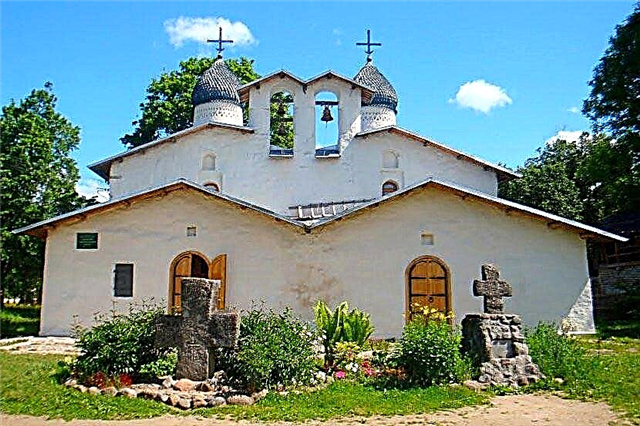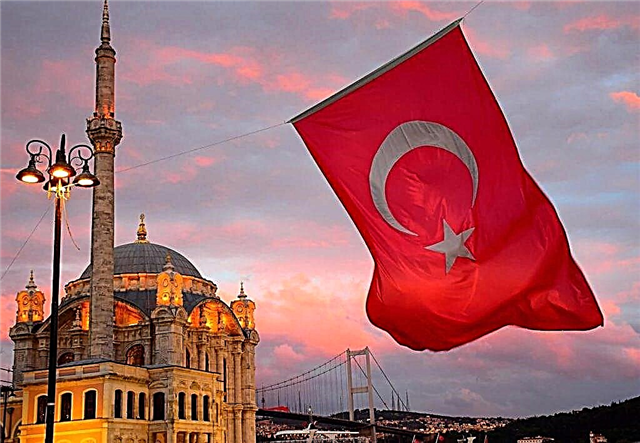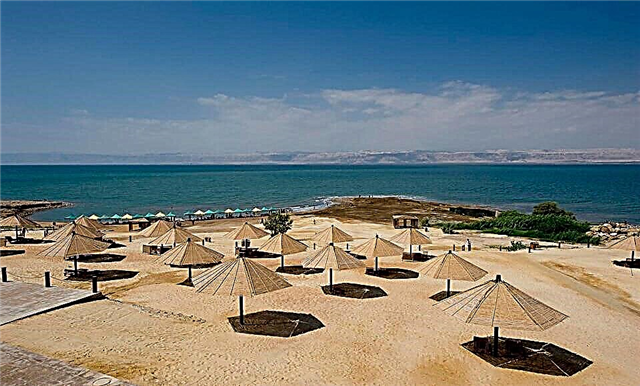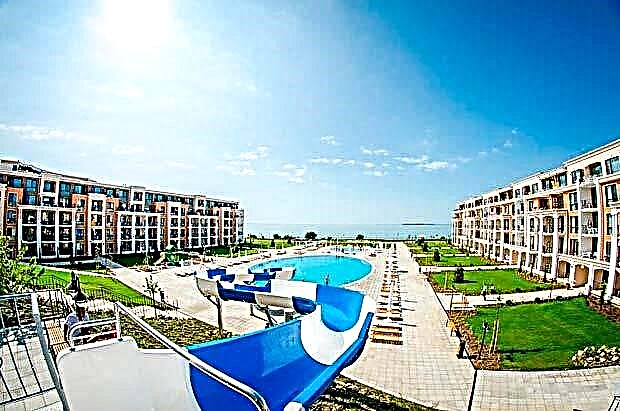Address: Russia, Pskov region, Pskov, st. Sverdlova, 1
First mention: 1399 year
Shrines: icon of the Pskov-Pokrovskaya Mother of God
Coordinates: 57 ° 48'19.2 "N 28 ° 20'02.6" E
Cultural heritage site of the Russian Federation
Content:
A small ancient church, which is often called the Intercession on the Corner or the Intercession on the Prolom, stands near the high Pokrovskaya tower, in the south-west of the Okolny town. Its architecture is unique for Russia - two separate churches have been merged under one roof. They have a common middle wall and look absolutely similar. The temple complex was built in the 16th century in memory of the defenders of the city during the bloody months-long siege of Pskov during the Livonian War.

View of the church from the side of the Velikaya river
Church history in the 15th-17th centuries
Several centuries ago, the Pokrovskaya monastery was located near the southwestern corner of the Okolny town. At the end of the XIV century, the Cathedral of the Intercession Church was built in it, from which the history of the double church at Prolom began.
At the beginning of the 16th century, next to the monastery, on the city fortifications, a new tower appeared, and by the name of the monastery they began to call it Pokrovskaya. The monastic buildings and the small Pokrovsky temple were located not far from the fortress wall between the Pokrovskaya and Svinuzka (or Pig) towers. Before the start of the Livonian War, no one suspected that it was here that the huge army of Stephen Batory would storm the city, and the section of the wall near the monastery would play a decisive role in the defense of Pskov.
In 1581, the leader of the Livonian army, the ambitious Stephen Bathory, went on a campaign against Pskov. He hoped that the capture of the Russian border town would open the way for his troops to Novgorod, and after him - to Moscow. The Russian sovereign John IV the Terrible suspected of the insidious plan of the Livonians and in advance concentrated large military forces in Pskov.
By the end of August 1581, the one hundred thousandth Livonian army approached the southern borders of the city. The size of Batory's troops is evidenced by the fact that the incoming detachments managed to fill the place prepared for the camp only after 14 hours. The Livonians were opposed by 20 thousand people from Pskov. To deprive the enemy of building materials and improve the view of the area, the inhabitants of Pskov went to an extreme step and completely burned out the townships outside the city walls.

View of the church from the north-west
The Poles decided to storm the fortress near the Pokrovskaya Tower and began preparatory work - digging trenches and building fortifications. Voivode Andrei Ivanovich Khvorostinin was responsible for the defense in this sector of the Okolny town. He ordered to build another one made of wood near the stone wall.
A few days later, having fired at the wall, the Livonians began an assault. In the breach made, they entered the Russian fortifications and captured the Svinuz tower. However, the city's defenders did not concede. The Pskovians managed to fire at the tower and blow it up together with the enemies who had settled there. The assault on the Livonians failed, and their main forces retreated.
Until the beginning of November, Batory's army made several attempts to take the city walls, but each time they failed. Then the troops decided to besiege the city and formed a blockade ring around it. But adversity did not break the Pskovites. For five and a half months, the Livonians made 31 attempts to storm Pskov, but they did not achieve anything and were eventually forced to retreat.
When peaceful life was restored in the city, grateful residents added a second church to the Church of the Intercession - Rozhdestvensky. The two churches formed a single temple complex, and the entrance to it was decorated with a belfry made in the best traditions of Pskov architecture. For a long time, a synodic was kept inside the church with the names of all those who died during the defense of Pskov in 1581-1582.

View of the church from the north-east
The shrine of the ancient church was also the Pskov-Pechora icon, which was revered as miraculous. The author of this image remained unknown, because medieval iconographers did not yet have a tradition to sign their works. And the plot of the icon was inspired by an old legend. Before the decisive assault on the Livonian troops, the elder of the Intercession Monastery, Dorotheos, had a dream in which the Mother of God appeared to him. She pointed out to Dorotheus that the army of Stefan Batory would inflict the main blow near the Pokrovskaya Tower. The elder's story about the miraculous vision was recorded directly on the icon, and she herself was placed in a beautiful silver frame.
Church history in the 18th-20th centuries
In 1764, during the church reform carried out by the decree of the Russian Empress Catherine II, the Intercession Monastery was abolished. The Church of the Intercession of the Nativity was left without a parish, and therefore it was assigned to the church of Nikita Gusyatnik.
In the middle of the 19th century, it was decided to reconstruct the ancient temple. The vestibules of both churches were enlarged, and the dilapidated wooden belfry was demolished. Instead, a two-pillar brick bell tower was built above the entrance, on which 5 bells were placed. According to documents preserved from those times, it is known that the church had one dome and had two thrones. The northern one was consecrated in honor of the Protection of the Mother of God, and the southern one - in honor of Christmas.
At the turn of the 19th-20th centuries, the temple was surrounded by a new fence and the church building and bell tower were covered with new metal. In 1912, Pskov archaeologists made an amazing discovery. They found an underground passage that connected the Pokrovskaya tower, the church and the famous Prolom in the fortress wall of the Okolny town.

View of the church from the street. Kalinin
With the advent of Soviet power, the ancient temple was closed. During the Great Patriotic War, the German invaders took out the old Pskov-Pechora icon from the country, and for a long time it was considered lost. The icon was discovered quite by accident in 1970, during an exhibition of Russian iconography, which was held in Munich. It turned out that she is in a private collection. In 2000, the icon was redeemed and returned to Russia. Today it can be seen in the Trinity Cathedral, and in the Church of the Intercession on Prolom there is a skillfully made copy of this image.
In 1960, the ancient temple received the status of a historical and architectural monument. And in 1966, separate scenes of Andrei Tarkovsky's historical film "Andrei Rublev" were filmed here.
The ancient church was returned to believers in 1993. However, for a long time, divine services were rarely held there, only 2-3 times a year. With the arrival of a new abbot in the mid-2000s, the situation changed. Now services in the ancient temple are held 2-3 times a week, according to the schedule.
Architectural features of the temple
The small graceful church was built of limestone slabs and together with the narthex measures 17 m by 15 m. The temple is unusual in architecture and consists of two churches merged into a single building - their fours have a common wall. Each of the churches has one altar apse and a vestibule with a separate entrance.
Written evidence has been preserved that at first the Intercession Church appeared, and after 1581, the Nativity Church was added to it from the south. However, there is another version, according to which both temples were erected at the same time. This opinion is supported by the fact that the fours have a common middle wall. Both porches also have a single wall.

Northern cross
The outer decor of the Church of the Intercession from Prolom is very modest. Only on both domes and apses can one see the ornament typical of Pskov architecture, consisting of expressive curbs and runners.
The last major restoration of the ancient church took place in 1961-1964 by the architect V.P. Smirnov. To restore the church to its original appearance, experts first studied ancient icons with images of the temple and its description. After that, the building was freed from the bell tower, and instead of it, a three-pillar Pskov belfry was erected on the western wall. The restorers covered both domes with a neat wooden ploughshare and redecorated the interior.
Current state and visiting regime
In our days, the Church of the Intercession and the Nativity of the Virgin is active. Its doors are open to believers and tourists every day from 10.00 to 17.00, as well as during church services. Services begin at 8.30 and 17.00. Inside there is a church shop, where, in addition to candles and icons, they sell small souvenirs. In winter, the temple is heated by a wood-burning stove, and therefore it is very cozy here on cold days.
Patronal holidays in the church are celebrated on October 14 - the day of the Intercession of the Theotokos, as well as September 21 - on the day of the decisive battle of the Russian troops with the army of Stefan Batory.
Massive stone crosses standing in front of the church remind of the famous storming of the city near the Pokrovsk monastery. In addition, a monument is dedicated to the 300th anniversary of the heroic defense of Pskov, which is installed in the western part of Victory Square, not far from the Church of the Intercession and the Nativity of the Virgin from Prolom.

The southern cross at the site of the appearance of the Mother of God to the blacksmith Dorofey and the burial place of the defenders of Pskov who died in 1581
How to get there
The ancient temple is located in the historical center of Pskov, on the right bank of the Velikaya, north of the bridge named after the 50th anniversary of October (Sverdlova st., 1). From the Pskov Kremlin it is easy to walk here along the embankment of the Velikaya River.
From the railway station (station "Pskov-Passenger") to the temple about 2 km. You need to go along the streets of Jan Fabricius, Kuznetskaya, Kalinin and Sverdlov. Those who want to drive up by buses or fixed-route taxis should get off at the Ploshchad Pobedy bus stop, from which the church is about 0.5 km away.
Motorists from the southern outskirts of Pskov need to turn off the Leningradskoye Highway onto Sovetskaya Armii Street, drive along it to the city center to Heroes-Paratroopers Square, and from here, along Sverdlov and Kalinin Streets, get to the church. The nearest car park is located on the street. Sverdlov.











